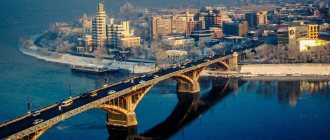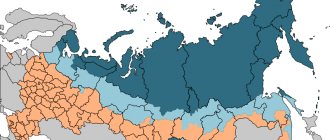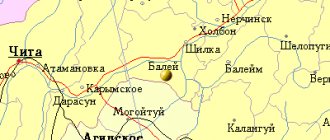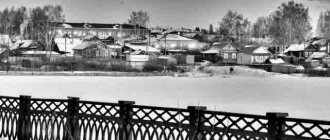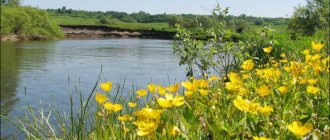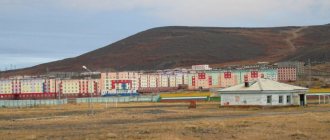Year founded: 1955
City Day is celebrated
on December 12
.
Hotel "Taiga" (Photo: S. Anisimov)
Bratsk
- a city in the Irkutsk region of Russia, located 490 km north of Irkutsk, in the center of the Angarsk Ridge, on the shore of the Bratsk Reservoir.
Historical reference
. A small fortress on the Angara River at the mouth of the Oka River was founded by Cossack explorers in 1631 and called it the Bratsk fortress. The origin of the name is explained by the Russian reinterpretation of the Buryat ethnonym into “brothers” - “brothers”.
After losing its military significance, the fort turned first into the village of Bratsko-Ostrozhnoe, then simply into Bratskoye and, finally, into Bratsk.
Bratsk Hydroelectric Power Station (Photo: www.bratsk-city.ru) In 1927, the Bratsk fort became the center of the Bratsk district of the Tulun district. In 1946, the Council of People's Commissars adopted the “Resolution on the organization of the Angarsk construction management.” In the fall of 1954, a resolution was adopted on the construction of the Bratsk hydroelectric power station. Thus began the construction of the Bratsk hydroelectric power station and the city of Bratsk. The site soon becomes an all-Union construction site.
In March 1957, the first closure of the Angara was completed, and in the summer of 1961 the filling of the Bratsk Reservoir began. Finally, on September 1, 1961, a historical event occurred - the birth of the Brotherly Sea. The village of Bratsk is flooded along with many other villages - in the Bratsk region alone, 119 settlements were resettled and went under water.
Near the drama theater (Photo: G. Taraskov)
The village of Bratsk itself was moved to a new location and, back in 1951, transformed into a workers’ village. In 1955, it was merged with a number of other villages and transformed into the city of Bratsk on December 12, 1955.
Today
Bratsk is one of the largest industrial centers of the Irkutsk region and Eastern Siberia. And although the city is located in harsh climatic conditions, its economic and geographical position is relatively favorable and is characterized by developed infrastructure.
Railway (Baikal-Amur Mainline), roads, power lines, an airport with international status, high resource and economic potential, electric power resources of the Bratsk Hydroelectric Power Station, unlimited water resources, shipping and timber rafting routes - Bratsk functions as an important support base for the development of the northern regions of Eastern Siberia and the Far East.
Night city (Photo: G. Taraskov)
The permanent population of Bratsk is more than 225 thousand people (2021). Mostly young people live here. The average age of city residents is 36 years, and children under 16 make up about 18%.
Not far from Bratsk, 60 km to the east, there is the Bratsk Seaside, a climatic resort area on the coast of the Bratsk Reservoir, where patients with diseases of the circulatory system and nervous system are treated. This is also facilitated by sodium sulfate-chloride water, found here in 1976.
Day of the city
dedicated to the day of its foundation and celebrated on December 12.
Flag
The flag of Bratsk is a rectangular panel with a height to width ratio of 2:3 (with a reproduction of the composition of the city’s coat of arms), dissected vertically, in the center, by a triple chipped pillar of blue color (comprising 0.2 the length of the flag), into two fields: red (0 .4 flag lengths) and green (0.4 flag lengths). Between the three parts of the triple column there are yellow gaps. On top of the triple pillar (in the central part of the flag and pillar), there is a sun (yellow), which has eight (shining) rays of light and eight “fiery” wavy rays. The diameter of the sun is 0.43 times the height of the panel.
Bratsk
Base
The founder of Bratsk is considered to be the Yenisei Cossack ataman Maxim Perfilyev. According to some historians, it was he who was the first Russian on the territory of the future city. The ataman brought information about this territory to Yeniseisk in 1627. In 1631, Perfilyev supervised the construction of the first Bratsk fortification, located near the Padunsky threshold.
However, despite the fact that the founding of Bratsk is traditionally attributed to Perfilyev, there was another person in the history of the city who, according to scientists, earned the right to be called the founder of the city much more than the Yenisei ataman. This man's name was Pyotr Beketov. Beketov is called the “godfather” of Bratsk. In 1629, the Yenisei centurion Pozdei Firsov drowned in the Ob. Two people applied for the vacant position at once - Maxim Perfilyev and Pyotr Beketov. The Tobolsk authorities preferred Beketov's candidacy, since complaints were constantly received against Perfilyev. Having become a centurion, Beketov with a small detachment went to the Buryat lands on a reconnaissance campaign.
The Buryat tribes greeted the Russians quite kindly. Many believe that this is due, first of all, to the weakness of the Buryat clans and their fear of firearms, which the Russians had. In fact, the local tribes were able to defend themselves. If they wanted, they could destroy a small detachment, despite the fact that the Cossacks had firearms. The Buryats sought to win over the powerful “white king”, who could protect them, if necessary, from unfriendly neighbors. Beketov, possessing the talent of a true diplomat, managed to convince the Buryat princes to accept Russian citizenship. Submission to the new ruler did not require anything from the tribes other than paying a small tribute. The annexed lands began to be called “bratskie”.
Bratsk prison
In 1635, a message was received in Yeniseisk that the garrison stationed in the Bratsk Fortress had been attacked by two Buryat princes. There were practically no survivors. The prison was burned. A year later, the fortification was rebuilt on the right bank of the Oka. Once again the fort was replaced in the 1640s, since the old one was already “small and thin.” In 1650, Pyotr Beketov began the development of arable farming near the next Bratsk fortification, considering the local lands suitable for farming. However, the small village at the fort was sparsely populated. There were almost no people willing to move to the fertile land. However, agriculture continued to develop despite the shortage of ploughmen.
At the beginning of the 18th century, the Bratsk fort and the adjacent village of Bratskoe were assigned to Yeniseisk, which remained under its subordination throughout the entire eighteenth century. The Brotherly fortification had its own clerk, which allowed the fortress to have some autonomy. By that time, the Brotherly Fortress had already become the administrative center for the volost of the same name, which included 15 villages. At the Bratsk fortress itself there were 25 households. In 1705, the Bratskaya volost was annexed to the Ilimsk Voivodeship. In 1710, a mass exodus of peasants was recorded in the volost. The reason for the flight was the numerous duties and taxes imposed on the population. As a result, the lands around the Bratsk fort quickly became empty. In 1713–1714 they tried to increase the population of the volost at the expense of Swedish captives. However, not a single Siberian woman wanted to marry a Swede, believing that such a marriage was a great sin for an Orthodox woman. Despite numerous persuasion from the authorities, it was not possible to marry most of the captives. Many Swedes could not stand the harsh Siberian climate and died.
Industry on the territory of the Bratsk fort originated in the middle of the 18th century. Local Cossacks submitted a petition for permission to build a distillery to the Irkutsk provincial office. Permission was received only after 8 years. It soon becomes known that iron ore lies not far from Bratsk. However, no one wanted to engage in mining. Only 4 people were engaged in metal processing in the Bratsk prison. The most popular craft was leatherworking. 14 people were engaged in this craft. At the end of the 18th century, a new version of the Russian Atlas was published. The publication included many settlements of Siberia that were not previously indicated on the map. The Bratsk volost continues to play a leading role in its region.
Fraternal Commissariat
In 1805, Eastern Siberia was divided into commissariatities. Irkutsk Governor-General Selifontov turned to the Tsar with a request to create a new administrative-territorial division for the Eastern Siberian land. Thus, Selifontov wanted to strengthen administrative supervision over the peasants. On April 22, 1805, the Fraternal Commissariat was formed, on the territory of which more than five thousand people lived.
The Bratsk prison had long ago become a place of exile for mostly political prisoners, one of whom was a member of the Union of Welfare, Pyotr Aleksandrovich Mukhanov. Staff Captain of the Life Guards Mukhanov did not participate in the December uprising of 1825. However, he was arrested and sentenced to exile in Siberia. In January 1826 he was sentenced to 12 years of hard labor. Then the sentence was commuted: the exile was reduced to eight years. Mukhanov visited the Petrovskaya and Chita prisons, after which he was transferred to the Bratsk prison. Subsequently, Mukhanov described his impressions of the fortress, calling it “a grave surrounded by pine trees” and coming to the conclusion that all the prisons he had visited were much better than the Bratsk prison and the adjacent settlement. At the request of Mukhanov, an architect who arrived from St. Petersburg created a plan for a wooden church, which was then built not far from the two ancient towers of the fort.
Nikolaevsky plant
In 1845, not far from the Bratsk Fortress, the construction of the state-owned Nikolaev iron and iron foundry began. Throughout the first half of the 19th century, iron ore was periodically found in the area of the fortress. This forced the tsarist government to think about serious development of deposits and further development of production in Siberia. The first melting at the new enterprise began in 1847. Construction of the plant was only fully completed in the 1850s. Over time, the state enterprise ended up in the hands of the private owner N.P. Lavrentyev.
In the early 1870s, a number of strikes and strikes were noted at the Nikolaevsky plant. On December 1, 1870, work at the plant was stopped completely. The foundry workers went on strike. The workers presented their claims to the management of the enterprise. The strike lasted more than 2 and a half months. The factory administration had to fulfill the workers' demands. Monthly cash payments at the enterprise were streamlined. Managers could now replace money with products when making payments only with the consent of the workers. The products of the Nikolaev plant were awarded a silver medal at the 1878 Paris World Exhibition. At home, the company's products were rated even higher. At an industrial exhibition in Moscow, the Nikolaev plant was awarded the right to use the state emblem on its label. Not every enterprise was awarded such a privilege.
In 1882, Bolshe-Mamyrskaya was separated from the Bratskaya volost. In the early 1890s, construction of the Trans-Siberian Railway began. The Nikolaev enterprise received an order from the government. It was necessary to produce rails for 3 million rubles. But one enterprise could not cope with the task. In order for the required amount of products to be produced on time, the construction of the Luchikhinsky ironworks began. In 1899, production was stopped at the Nikolaev plant. In those years, the owner of the enterprise was the famous manufacturer Savva Mamontov. Having no working capital, the manufacturer was forced to fire 5 thousand workers who were left without a livelihood. The dismissed people organized a working committee, which presented a number of economic demands to the plant administration. The managers were forced to turn to the gendarmes for help. However, the situation became so threatening that the factory administration had to give the workers food and money.
Bratsk in the twentieth century
The workers' struggle for their rights continued in the revolutionary year of 1917. Even before the official change of power in Bratsk, a bailiff was arrested. A meeting was held at the Nikolaevsky plant, at which workers elected members of the revolutionary committee, with the help of which agitation for a new government was organized in the Bratsk volost. Thanks to the committee, wages at the plant were increased, fixed prices for products were established, and the working day was reduced to 8 hours. In November 1917, news arrived in the city that the tsarist government had been overthrown. At the beginning of 1918, the Nikolaev plant was nationalized.
The final victory of Soviet power was still far away. In September 1919, fierce battles took place in the village of Bratskoye between partisans and Kolchak’s detachments. The Nikolaev plant at that time was occupied by the White Guards. Supporters of the new government were mostly located outside the village. After the end of the civil war, devastation reigned in the Bratsk volost. Through the efforts of workers and Bolsheviks, the Nikolaevsky and Luchikhinsky factories were launched in 1921. Cooperation came to the aid of the poorest residents of local villages, providing benefits and opening loans. Thanks to cooperation, a huge number of farm laborers and poor people were saved from exploitation by the kulaks.
The relatively stable development of the village of Bratskoye continued until the start of the Great Patriotic War. At the end of June 1941, many applications were submitted to the village military registration and enlistment office: village residents volunteered for the front. The collective farmers who remained in the rear actively helped their comrades who had left to defend their homeland. In 1942, the women of the village of Bratskoye knitted about two thousand pairs of socks and woolen mittens for the Red Army soldiers. Despite the difficult military situation in the country, a fish factory was built in the village. The workers made a unanimous decision to contribute 25–50% of their wages to the construction of the Irkutsk Collective Farmer tank column. Hunting for fur-bearing animals has long been considered one of the main industries on the fraternal land. During the war years, each local hunter was obliged to hand over furs worth at least 475 rubles. Many hunters exceeded the plan.
After the end of the war, development of a project for the construction of the Bratsk hydroelectric power station began. It was also necessary to pay special attention to the development of agriculture, which was supposed to ensure large-scale construction. In 1951, the village of Bratskoye received the status of a working village. The decree on the construction of the hydroelectric power station was signed in 1954. Construction of the hydroelectric power station began in early 1955. In addition to the hydroelectric power station, in the post-war years a large number of important enterprises for the settlement were opened in Bratsk.
City of Bratsk
In 1955, the workers' village was transformed into the city of Bratsk. The city included a number of settlements located near Bratsk. Many residential areas of the modern city were originally small villages. Most of them appeared in the 1950s. Green Town, one of the settlements that became part of Bratsk, got its name because of the color of the tents located on the banks of the Angara. The tents were put up here for temporary living, but they lasted 2 years. It was not customary to call this temporary settlement a town, village, hamlet, etc. It was called exclusively a town, in the hope that sooner or later there would be a city in this place. The green town existed for several years. A bathhouse, a canteen, a clinic and a school appeared here. More than six thousand people lived in the town. In the spring of 1961, the town ceased to exist, and the place on which it was located was flooded by a reservoir in the fall of the same year.
In 1956, construction of wooden cottages began in the village of Padun. Then they began to build two-, eight- and sixteen-story houses here. The village changed its name several times. It was called the village of the Left Bank, Pursey and Constant. In the end, it was decided to keep its original name. For ten years (1957–1967), Padun was considered the center of Bratsk, since many of the administrative buildings of the young city were located here.
In 1959, construction began on the village of Energetik, originally called the New City. This settlement was located closest to all others to the Bratsk hydroelectric power station. The power plant was built for construction industry workers and hydroelectric power plant specialists.
The village of Gidrostroitel was initially called the Right Bank. Its construction began in 1955. The settlement grew and developed at a very fast pace. Here they created the main but temporary production base for the construction of the Bratsk hydroelectric power station. The village got its name in honor of the builders of the hydroelectric power station. At first it was built up with wooden apartment and barracks-type buildings. Over time, a trend towards individual development emerged.
In 1959, the village of Sukhoi was founded. A geological exploration expedition was located in this settlement. In 1960, the villages of Sukhoi and Osinovka were united into the Osinovsky Village Council of Workers' Deputies.
The village of Porozhsky (from the word “threshold”) arose in connection with the resettlement from the flood zone. The official founding date of the village was December 27, 1960, but in fact the village appeared much earlier. Porozhsky also had other names: Upper Village and Lower Village.
Thanks to these and some other settlements, Bratsk gradually grew over the years.
The 90s were the most difficult years for modern Bratsk. In May 1990, there was a speech by the city’s medical personnel (more than six thousand people). Health workers demanded that the authorities increase wages, improve living conditions and provide their children with places in kindergartens. In the 90s, the number of people wishing to immigrate abroad increased significantly. Most immigrants went to Israel. One of the tragic pages in the history of Bratsk was the forest fires that occurred in the Bratsk region. The fire spread so quickly that it led to severe smoke in the city.
